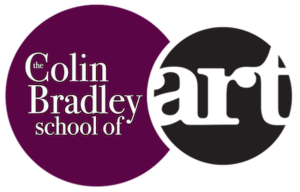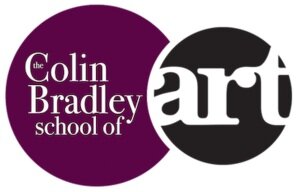Curtain, Jug and Fruit by Paul Cézanne in Pastel Pencils
Our 4th Advanced Demonstration that we added in February 2019 is an impressionistic painting - “Curtain, Jug and Fruit” by Paul Cézanne.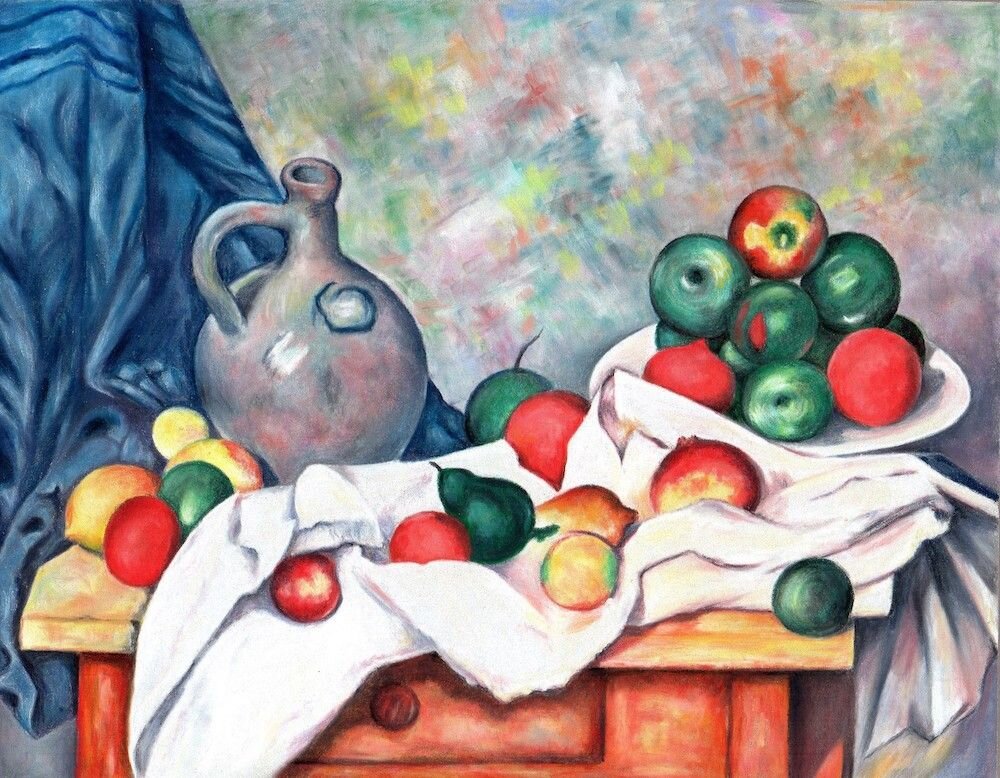 Our Pastel Pencil demonstrations show advanced techniques and are designed to show how far you can push the pastel pencil medium.We are venturing with these demonstrations to enter the world of impressionism and how to emulate the great artists. As stated, these are demonstrations, so if you would like to follow along then you can give it a go. However, they are going to be difficult.Saying that, there is so much you can learn from simply watching the demonstration and how Colin achieves these effects with Pastels.The demonstration is 3 hours long, split into 3 parts and is available to ALL IN Members only. To see our membership plans click here.To view the demonstration, members login and go to the “Demonstrations” section under the Pastel Pencil heading. Alternatively, click here to go straight to it ????If you would like to hear more about the picture, why Colin chose this subject and the materials behind it, listen to our podcast below. We’ve also included a transcription if you would like to read along.Download this Podcast
Our Pastel Pencil demonstrations show advanced techniques and are designed to show how far you can push the pastel pencil medium.We are venturing with these demonstrations to enter the world of impressionism and how to emulate the great artists. As stated, these are demonstrations, so if you would like to follow along then you can give it a go. However, they are going to be difficult.Saying that, there is so much you can learn from simply watching the demonstration and how Colin achieves these effects with Pastels.The demonstration is 3 hours long, split into 3 parts and is available to ALL IN Members only. To see our membership plans click here.To view the demonstration, members login and go to the “Demonstrations” section under the Pastel Pencil heading. Alternatively, click here to go straight to it ????If you would like to hear more about the picture, why Colin chose this subject and the materials behind it, listen to our podcast below. We’ve also included a transcription if you would like to read along.Download this Podcast
Transcription:
Stephen Bradley: We're going to talk about (finally) the Cezanne picture that we put up the demonstration that we put up a couple of weeks ago n ow was it? Yeah a few weeks a go the next demonstration the fourth one I believe. Something completely different. So let's talk about firstly why did you choose this one? Because this is quite different.Colin Bradley: It's very different and that's probably the main reason why I chose it. I thought I need to challenge myself. I've done a lot of Impressionism in my artwork - backgrounds and sometimes in the in the art itself, y ou know the animals and landscape particularly but I haven't really pushed the boat out. I thought I'm gonna do it with this one. And Cezanne is known for the Impressionist pictures. I went through quite a few different pictures he's got a nd this particular one it seems it's considered the most expensive still life ever sold. So I thought well it's obviously popular and I thought we'll give it a go. I was particularly attracted because when I've done still life before and if I've done an apple or an orange or a banana or whatever I've always stuck to the rigidly to the colours s o it was real. But of course he doesn't do that at all. He has a whole variety. He just does what he wants and what he fancies and what is appealing. I was attracted by that and the fact that I wanted to produce pictures and still do and have done as you know for people to display on their walls and talking points and this sort of thing. And so that's the reason I really wanted to do something really different and to test me and pastel pencil because that's primarily the reason I do it so that we can see just how far we can take the pastel pencil and the chalks.Stephen Bradley: So did it test you?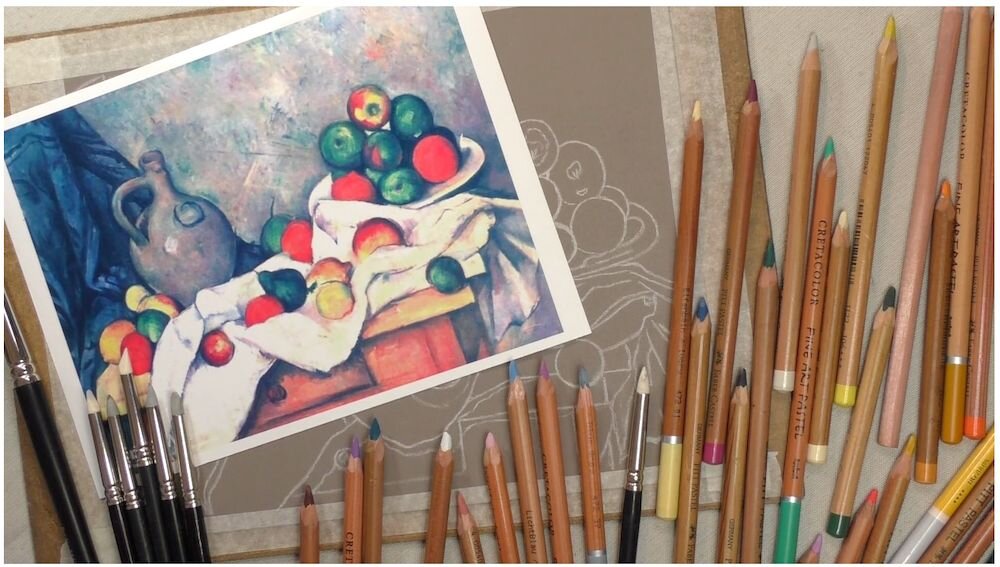 Colin Bradley: Yes it did. Without doubt although I've got to say I found it easier than I thought I would have done. When I first started it I thought am I going to really enjoy this. But I did. And consequently as you know I have done another one since then another well-known Cezanne because I thought right I like the idea of it and the pastel pencils work brilliantly as well. I didn't have to resort to the soft pastel which I thought I would have to. They did the job for me. I think it maybe because we increased the colour range and we'd brought in the cretacolor . We hadn't brought in any of the other pencils but no I think I had used a couple of CarbOthello on that didn't know because I've got a whole set of CarbOthello. But we're not gonna push the boat out too much on that because we haven't as yet got the okay...Stephen Bradley: We have. Yeah. I had a phone call this morning. So we're getting them in.Colin Bradley: Oh well there we are folks. Well I can I can start including more. In the work I do because you know it's a bit frustrating you know when you have a pencil and you think "Oh I can't get hold of that one".Stephen Bradley: Yeah we'll be selling them individually so people can, if you've used a couple, they can just buy those couple.Colin Bradley: Yeah that's right. Yeah. Okay well that's fine. So you'll be seeing even more. So what I was saying by increasing the range of colours. It's increased the range of spectrum that I can work in.
Colin Bradley: Yes it did. Without doubt although I've got to say I found it easier than I thought I would have done. When I first started it I thought am I going to really enjoy this. But I did. And consequently as you know I have done another one since then another well-known Cezanne because I thought right I like the idea of it and the pastel pencils work brilliantly as well. I didn't have to resort to the soft pastel which I thought I would have to. They did the job for me. I think it maybe because we increased the colour range and we'd brought in the cretacolor . We hadn't brought in any of the other pencils but no I think I had used a couple of CarbOthello on that didn't know because I've got a whole set of CarbOthello. But we're not gonna push the boat out too much on that because we haven't as yet got the okay...Stephen Bradley: We have. Yeah. I had a phone call this morning. So we're getting them in.Colin Bradley: Oh well there we are folks. Well I can I can start including more. In the work I do because you know it's a bit frustrating you know when you have a pencil and you think "Oh I can't get hold of that one".Stephen Bradley: Yeah we'll be selling them individually so people can, if you've used a couple, they can just buy those couple.Colin Bradley: Yeah that's right. Yeah. Okay well that's fine. So you'll be seeing even more. So what I was saying by increasing the range of colours. It's increased the range of spectrum that I can work in.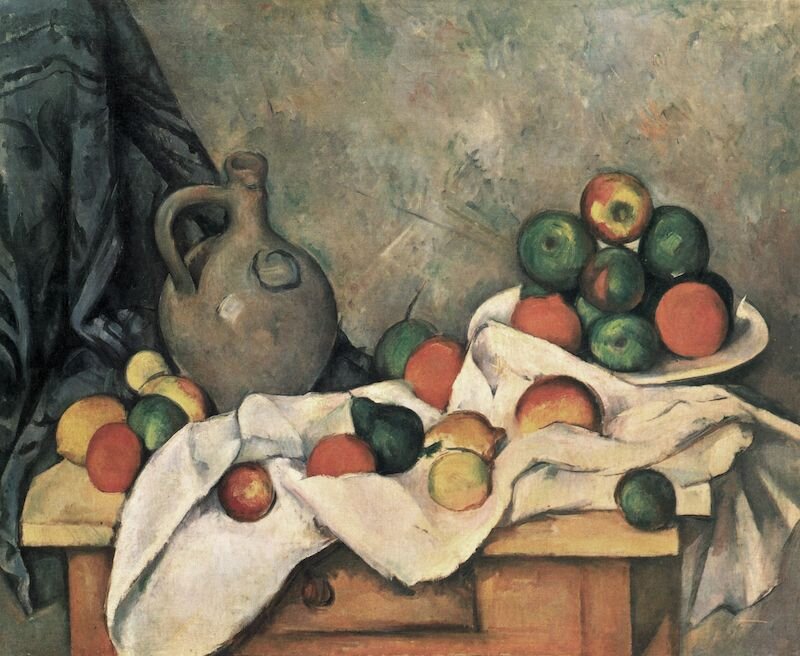 Stephen Bradley: Do you think as well you said earlier just picking up on what you said about didn't need to use soft pastel is that because these pencils are softer?Colin Bradley: Yes. Well the cretacolor are. The degree of softness is the new pencils we're using the Caran D'Ache pencils which I've started to use they're the softest of all of the four makes that we've got. Then I would say probably comes cretacolor. They've got a different feel to the Stabilo, they are a bit more Chalky. And then of course the Faber is stronger and harder and certainly will always be I think the mainstay of my work because they still have that quality about them. But by adding the other pencils it gives me opportunities just to do pictures like Cezanne and the curtain jug and fruit which is the one I did and others as well. The problem we have and I'm sure everybody knows with the pastel pencil you can't mix it very easily. With oil, water colour and so on you could just mix the paints up and get the exact tone that you want. You can't do that so well with the pastel pencil. So consequently you've really got to have a larger range of pencils or you have to compromise. And that's one thing I'm not very good at compromising I'd much prefer to use a colour that I have in my head. That does the job for me.Stephen Bradley: I think in the past you've had to in terms of your teaching you know in terms of classes and workshops and keeping it all quite structured and now we're at a point where I mean the people that join us do such amazing work and a lot of them have gone off to have very successful careers and it's now getting to the point where the ability of the student is changing. We're able to show six or seven other colours and then another couple of other colours and it not to be overwhelming because if they've reached that point and they've gone through 200 projects on the site oh they're well ready for their own palette of fresh range of colours. I do think then because of the extended ranges of Cretacolor and Caran D'Ache and the fact that their makeup is different that is clearly to do with allowing a bigger range of pigment. Because the textures changed and things that you have brighter colours, more colours.Colin Bradley: Absolutely and I'm also finding though the added bonus which I didn't realise is that the different textures can create different effects. I found that recently on the on the last picture I've done which is an animal and I found that I could do things which I've never done before as successfully as I've done now and it's because we've got different textures but especially when you go close up too. When I look at my work back because I always look back on the work I look it much closer than I would normally see it in real life and I can see then then the combination of the different textures go to make an even yet another dimension to the picture. Very difficult to explain this. I think people will see it eventually when these new pictures come out they'll see a slight change. What it is, instead of being exact you know not absolutely precise every hair in place I'm being able because of the combination of the different pencils I'm being able to manipulate those so they become fused a lot of them together and create the completely different effect, it's softer but it's more satisfying I suppose from an artist's point of view. I'm sure people looking at the pictures laymen looking at the pictures wouldn't see it but an artist would they're seeing something different they're being able to create an imagery which up to now I haven't seen before. And this is very exciting for me as you can imagine. And I think it will be for people looking at them thinking how on earth has he created that effect. I looked at the great paintings of the great artists I used to look at their paintings once and think how on earth did they get that how did they manage to do it. I'm now seeing in my own work things like that because when I look back I think how did I do that. How how did that happen. Well we know how it happens because when you're immersed in your artwork you become a completely different frame of reference. It's amazing, music's the same, a great musician when you see them very often nodding away you know they're lost, immersed in their own musical creativity. You can see that it's very obvious when you look at it. It's exactly the same with an artist. You get immersed in it. And even though I'm chatting away nine to the dozen you know telling people what to do I'm still being able to create that same feeling. So it's very exciting. Yeah very exciting.
Stephen Bradley: Do you think as well you said earlier just picking up on what you said about didn't need to use soft pastel is that because these pencils are softer?Colin Bradley: Yes. Well the cretacolor are. The degree of softness is the new pencils we're using the Caran D'Ache pencils which I've started to use they're the softest of all of the four makes that we've got. Then I would say probably comes cretacolor. They've got a different feel to the Stabilo, they are a bit more Chalky. And then of course the Faber is stronger and harder and certainly will always be I think the mainstay of my work because they still have that quality about them. But by adding the other pencils it gives me opportunities just to do pictures like Cezanne and the curtain jug and fruit which is the one I did and others as well. The problem we have and I'm sure everybody knows with the pastel pencil you can't mix it very easily. With oil, water colour and so on you could just mix the paints up and get the exact tone that you want. You can't do that so well with the pastel pencil. So consequently you've really got to have a larger range of pencils or you have to compromise. And that's one thing I'm not very good at compromising I'd much prefer to use a colour that I have in my head. That does the job for me.Stephen Bradley: I think in the past you've had to in terms of your teaching you know in terms of classes and workshops and keeping it all quite structured and now we're at a point where I mean the people that join us do such amazing work and a lot of them have gone off to have very successful careers and it's now getting to the point where the ability of the student is changing. We're able to show six or seven other colours and then another couple of other colours and it not to be overwhelming because if they've reached that point and they've gone through 200 projects on the site oh they're well ready for their own palette of fresh range of colours. I do think then because of the extended ranges of Cretacolor and Caran D'Ache and the fact that their makeup is different that is clearly to do with allowing a bigger range of pigment. Because the textures changed and things that you have brighter colours, more colours.Colin Bradley: Absolutely and I'm also finding though the added bonus which I didn't realise is that the different textures can create different effects. I found that recently on the on the last picture I've done which is an animal and I found that I could do things which I've never done before as successfully as I've done now and it's because we've got different textures but especially when you go close up too. When I look at my work back because I always look back on the work I look it much closer than I would normally see it in real life and I can see then then the combination of the different textures go to make an even yet another dimension to the picture. Very difficult to explain this. I think people will see it eventually when these new pictures come out they'll see a slight change. What it is, instead of being exact you know not absolutely precise every hair in place I'm being able because of the combination of the different pencils I'm being able to manipulate those so they become fused a lot of them together and create the completely different effect, it's softer but it's more satisfying I suppose from an artist's point of view. I'm sure people looking at the pictures laymen looking at the pictures wouldn't see it but an artist would they're seeing something different they're being able to create an imagery which up to now I haven't seen before. And this is very exciting for me as you can imagine. And I think it will be for people looking at them thinking how on earth has he created that effect. I looked at the great paintings of the great artists I used to look at their paintings once and think how on earth did they get that how did they manage to do it. I'm now seeing in my own work things like that because when I look back I think how did I do that. How how did that happen. Well we know how it happens because when you're immersed in your artwork you become a completely different frame of reference. It's amazing, music's the same, a great musician when you see them very often nodding away you know they're lost, immersed in their own musical creativity. You can see that it's very obvious when you look at it. It's exactly the same with an artist. You get immersed in it. And even though I'm chatting away nine to the dozen you know telling people what to do I'm still being able to create that same feeling. So it's very exciting. Yeah very exciting.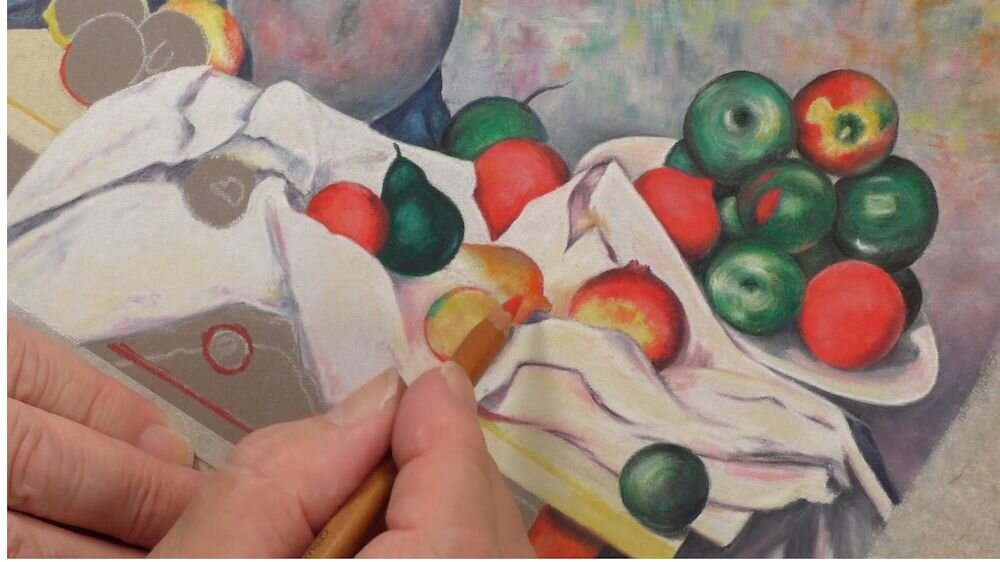 Stephen Bradley: What challenges did you have on this particular picture?Colin Bradley: I think probably what it was it was getting over the fact that I can put green, red and blue in areas where there isn't or shouldn't be green, red and blue. With that particular picture I thought does it work? But when I look back on it it does work. It works because it's pleasing to the eye. And that's what the difference I think. Because I'm doing those kind of things or breaking the mould so to speak that's allowed me to think differently as well.Stephen Bradley: Does that change your realistic drawing as well?Colin Bradley: Absolutely yes. And people will see that as time goes on.Stephen Bradley: You're putting green and blue now in your tiger work?Colin Bradley: Well strangely enough I am putting different colours. You've got to be careful when you're dealing with animals. I've got to tell you that because if you if you start doing that with animals you're taking a liberty.Stephen Bradley: You did it with brickwork?Colin Bradley: I do it with brickwork and with yes a lot of landscape work I do and portraits as well. I'm doing a new portrait very soon which I'm very excited about and this is from another famous artist. It's going to be lots more colours put into flesh. I'm looking forward to that because it will teach me how to still create the imagery but actually put slight more interest in the build up. I am doing it. I did it with the Victorian portrait recently.Stephen Bradley: Isn't that an interesting skill that they would still be able to create harmony within the tones yet put quite obscure colours in.Colin Bradley: Mm hmm. A lot of the famous really well known artists do that anyway. They mix their colours so that you get different tones.Stephen Bradley: You still have harmony but it doesn't look Oh that's harsh. Yet, they shouldn't go together. That's the beauty of it.Colin Bradley: That's right. Yeah. I think if you're doing the kind of work that I'm doing now you kind of automatic you're being guided all the time. You pick up a pencil and think that's not going to work. You know instinctively that that's not going to work together and it wouldn't do if you put it in it would clash you can't have any of that. So it's gonna be great great fun. But I think the Impressionists have taught me this that particular picture taught me - it was a turning point.
Stephen Bradley: What challenges did you have on this particular picture?Colin Bradley: I think probably what it was it was getting over the fact that I can put green, red and blue in areas where there isn't or shouldn't be green, red and blue. With that particular picture I thought does it work? But when I look back on it it does work. It works because it's pleasing to the eye. And that's what the difference I think. Because I'm doing those kind of things or breaking the mould so to speak that's allowed me to think differently as well.Stephen Bradley: Does that change your realistic drawing as well?Colin Bradley: Absolutely yes. And people will see that as time goes on.Stephen Bradley: You're putting green and blue now in your tiger work?Colin Bradley: Well strangely enough I am putting different colours. You've got to be careful when you're dealing with animals. I've got to tell you that because if you if you start doing that with animals you're taking a liberty.Stephen Bradley: You did it with brickwork?Colin Bradley: I do it with brickwork and with yes a lot of landscape work I do and portraits as well. I'm doing a new portrait very soon which I'm very excited about and this is from another famous artist. It's going to be lots more colours put into flesh. I'm looking forward to that because it will teach me how to still create the imagery but actually put slight more interest in the build up. I am doing it. I did it with the Victorian portrait recently.Stephen Bradley: Isn't that an interesting skill that they would still be able to create harmony within the tones yet put quite obscure colours in.Colin Bradley: Mm hmm. A lot of the famous really well known artists do that anyway. They mix their colours so that you get different tones.Stephen Bradley: You still have harmony but it doesn't look Oh that's harsh. Yet, they shouldn't go together. That's the beauty of it.Colin Bradley: That's right. Yeah. I think if you're doing the kind of work that I'm doing now you kind of automatic you're being guided all the time. You pick up a pencil and think that's not going to work. You know instinctively that that's not going to work together and it wouldn't do if you put it in it would clash you can't have any of that. So it's gonna be great great fun. But I think the Impressionists have taught me this that particular picture taught me - it was a turning point.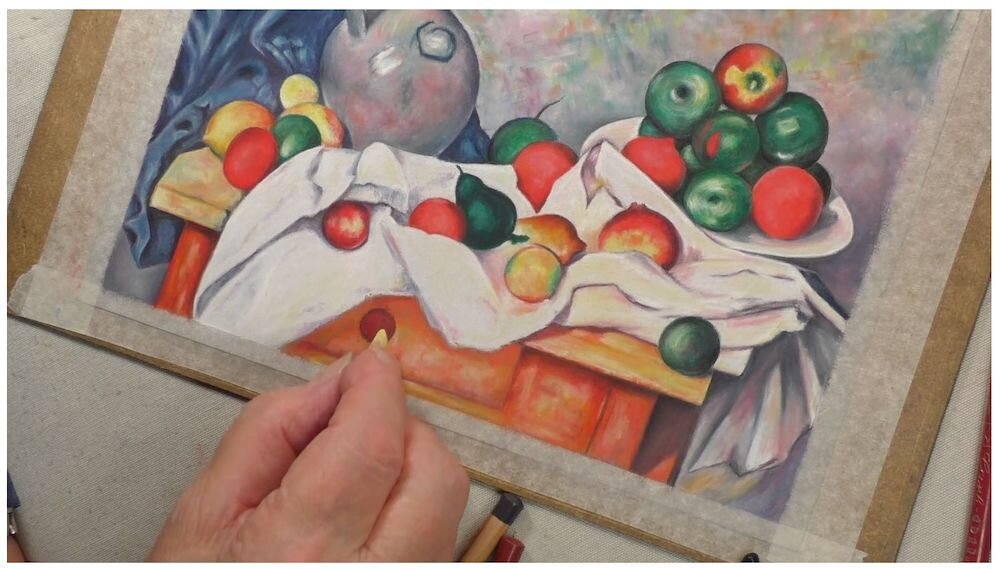 Stephen Bradley: So what tips would you give people if they wanted to start this picture. What advice would you give them?Colin Bradley: Go for it. We've had a couple of our members do it and I'm sure you've seen on Facebook and they've done a really really good job of it. Now whether they could have done it without my help and watching me do it remains to be seen because once you've seen somebody do it like I followed another picture - you've got an idea of what can work. The difficulty is then going out and doing your own that would be the test. But copying isn't so bad but it does at least allow you to break away from maybe a mould that you've established for yourself. Follow what I do. When I first started out I used to copy everybody you know all the great artists and all the pictures and this is sort of a norm when you start out because you've got to learn and you do learn from that then you start breaking away from that. And so I would say just go for it. Just do it. It doesn't matter if it doesn't work. The whole idea of this is to enjoy and immerse yourself in something that's very very different. When I first did this when I first started these pictures off and there's quite a few now in the pipeline I didn't expect people to be able to do them. I thought they were too hard. I told you that but there we are. The Victorian lady when I did that I thought well I've done it as a class picture but are people going to be able to do it. Well it's proved that they can and they have and they've done a good job too.Stephen Bradley: Okay great. I think that's a good discussion on the Cezanne picture. I think this introduces it really nicely if people haven't given it a go and gives a bit of background on how you found that whole process. So we'll have another demonstration coming out in May that people will be able to look forward to and in the meantime we're going to record another podcast separate from this where we can answer some of your questions.
Stephen Bradley: So what tips would you give people if they wanted to start this picture. What advice would you give them?Colin Bradley: Go for it. We've had a couple of our members do it and I'm sure you've seen on Facebook and they've done a really really good job of it. Now whether they could have done it without my help and watching me do it remains to be seen because once you've seen somebody do it like I followed another picture - you've got an idea of what can work. The difficulty is then going out and doing your own that would be the test. But copying isn't so bad but it does at least allow you to break away from maybe a mould that you've established for yourself. Follow what I do. When I first started out I used to copy everybody you know all the great artists and all the pictures and this is sort of a norm when you start out because you've got to learn and you do learn from that then you start breaking away from that. And so I would say just go for it. Just do it. It doesn't matter if it doesn't work. The whole idea of this is to enjoy and immerse yourself in something that's very very different. When I first did this when I first started these pictures off and there's quite a few now in the pipeline I didn't expect people to be able to do them. I thought they were too hard. I told you that but there we are. The Victorian lady when I did that I thought well I've done it as a class picture but are people going to be able to do it. Well it's proved that they can and they have and they've done a good job too.Stephen Bradley: Okay great. I think that's a good discussion on the Cezanne picture. I think this introduces it really nicely if people haven't given it a go and gives a bit of background on how you found that whole process. So we'll have another demonstration coming out in May that people will be able to look forward to and in the meantime we're going to record another podcast separate from this where we can answer some of your questions.
Membership
This and all our other advanced demonstrations can be found inside our ALL IN membership. To learn more about our membership and how you can get:
- Access to ALL our courses
- Feedback on your Artwork from Colin
- Access to our advanced Demonstrations
- 80 Written Instruction Packs (Worth £239)
- 10 E-Books (Worth £29)
- 33 Exercise Sheets (Worth £26)
Click here.For those that are already members we hope you enjoy the new Demonstration and we can't wait to show you the next one![fusion_tagline_box backgroundcolor="" shadow="no" shadowopacity="0.7" border="0" bordercolor="" highlightposition="left" content_alignment="left" link="https://colinbradleyart.com/draw-stunning-pastel-pictures-with-our-free-lessons/" button="FREE COURSES" linktarget="_self" modal="" button_size="" button_type="flat" button_shape="square" buttoncolor="default" title="Try Our Free Courses" description="Interested in trying Pastel Pencils? We have free courses for drawing Animals, Landscapes and Portraits." margin_top="" margin_bottom="" hide_on_mobile="small-visibility,medium-visibility,large-visibility" class="" id="" animation_type="" animation_direction="left" animation_speed="0.3" animation_offset=""][/fusion_tagline_box]
